CHRYSLER 200 2015 2.G User Guide
Manufacturer: CHRYSLER, Model Year: 2015, Model line: 200, Model: CHRYSLER 200 2015 2.GPages: 220, PDF Size: 3.7 MB
Page 191 of 220
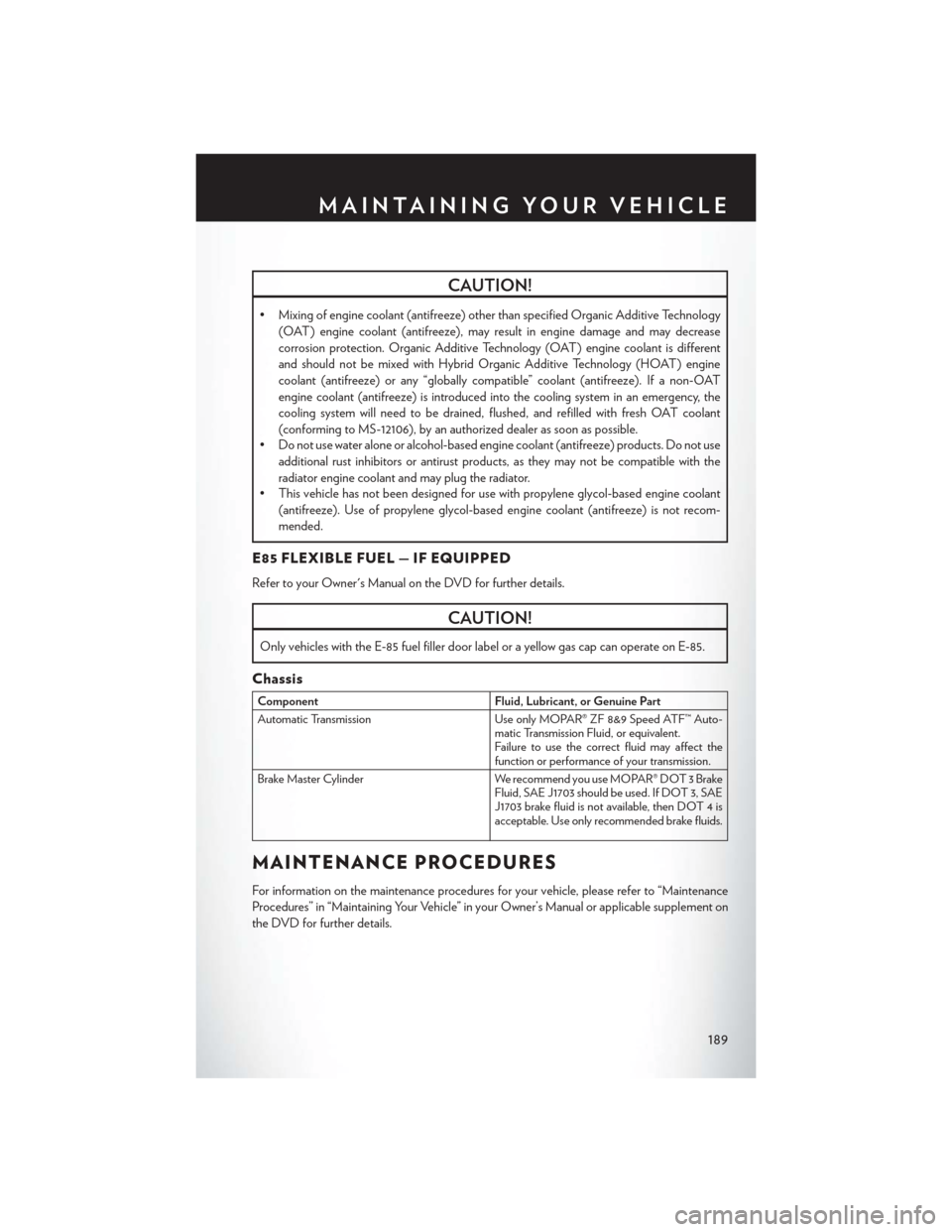
CAUTION!
• Mixing of engine coolant (antifreeze) other than specified Organic Additive Technology(OAT) engine coolant (antifreeze), may result in engine damage and may decrease
corrosion protection. Organic Additive Technology (OAT) engine coolant is different
and should not be mixed with Hybrid Organic Additive Technology (HOAT) engine
coolant (antifreeze) or any “globally compatible” coolant (antifreeze). If a non-OAT
engine coolant (antifreeze) is introduced into the cooling system in an emergency, the
cooling system will need to be drained, flushed, and refilled with fresh OAT coolant
(conforming to MS-12106), by an authorized dealer as soon as possible.
• Do not use water alone or alcohol-based engine coolant (antifreeze) products. Do not use
additional rust inhibitors or antirust products, as they may not be compatible with the
radiator engine coolant and may plug the radiator.
• This vehicle has not been designed for use with propylene glycol-based engine coolant
(antifreeze). Use of propylene glycol-based engine coolant (antifreeze) is not recom-
mended.
E85 FLEXIBLE FUEL — IF EQUIPPED
Refer to your Owner's Manual on the DVD for further details.
CAUTION!
Only vehicles with the E-85 fuel filler door label or a yellow gas cap can operate on E-85.
Chassis
Component Fluid, Lubricant, or Genuine Part
Automatic Transmission Use only MOPAR® ZF 8&9 Speed ATF™ Auto-
matic Transmission Fluid, or equivalent.
Failure to use the correct fluid may affect the
function or performance of your transmission.
Brake Master Cylinder We recommend you use MOPAR® DOT 3 Brake
Fluid, SAE J1703 should be used. If DOT 3, SAE
J1703 brake fluid is not available, then DOT 4 is
acceptable. Use only recommended brake fluids.
MAINTENANCE PROCEDURES
For information on the maintenance procedures for your vehicle, please refer to “Maintenance
Procedures” in “Maintaining Your Vehicle” in your Owner’s Manual or applicable supplement on
the DVD for further details.
MAINTAINING YOUR VEHICLE
189
Page 192 of 220
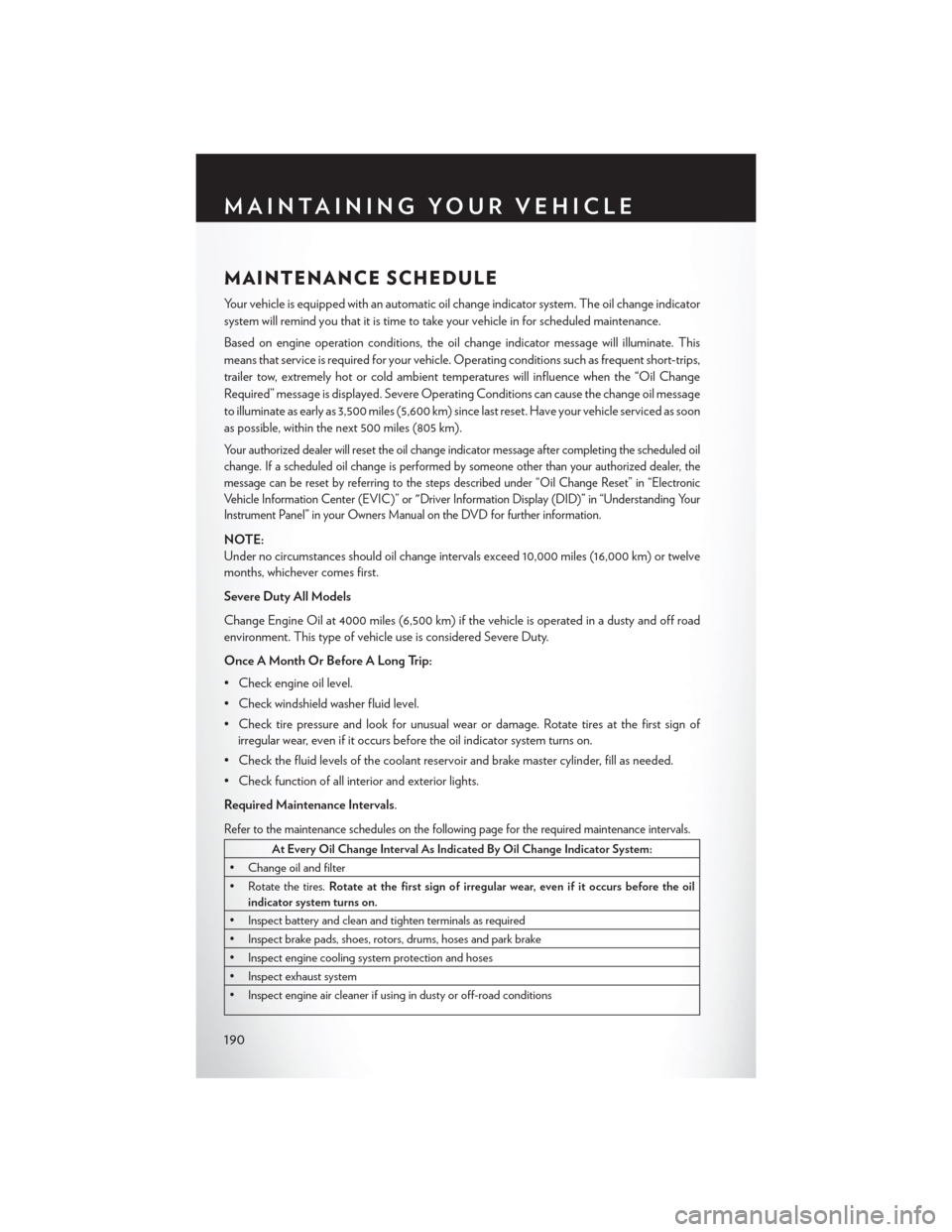
MAINTENANCE SCHEDULE
Your vehicle is equipped with an automatic oil change indicator system. The oil change indicator
system will remind you that it is time to take your vehicle in for scheduled maintenance.
Based on engine operation conditions, the oil change indicator message will illuminate. This
means that service is required for your vehicle. Operating conditions such as frequent short-trips,
trailer tow, extremely hot or cold ambient temperatures will influence when the “Oil Change
Required” message is displayed. Severe Operating Conditions can cause the change oil message
to illuminate as early as 3,500 miles (5,600 km) since last reset. Have your vehicle serviced as soon
as possible, within the next 500 miles (805 km).
Your authorized dealer will reset the oil change indicator message after completing the scheduled oil
change. If a scheduled oil change is performed by someone other than your authorized dealer, the
message can be reset by referring to the steps described under “Oil Change Reset” in “Electronic
Vehicle Information Center (EVIC)” or "Driver Information Display (DID)” in “Understanding Your
Instrument Panel” in your Owners Manual on the DVD for further information.
NOTE:
Under no circumstances should oil change intervals exceed 10,000 miles (16,000 km) or twelve
months, whichever comes first.
Severe Duty All Models
Change Engine Oil at 4000 miles (6,500 km) if the vehicle is operated in a dusty and off road
environment. This type of vehicle use is considered Severe Duty.
Once A Month Or Before A Long Trip:
• Check engine oil level.
• Check windshield washer fluid level.
• Check tire pressure and look for unusual wear or damage. Rotate tires at the first sign ofirregular wear, even if it occurs before the oil indicator system turns on.
• Check the fluid levels of the coolant reservoir and brake master cylinder, fill as needed.
• Check function of all interior and exterior lights.
Required Maintenance Intervals.
Refer to the maintenance schedules on the following page for the required maintenance intervals.
At Every Oil Change Interval As Indicated By Oil Change Indicator System:
• Change oil and filter
• Rotate the tires. Rotate at the first sign of irregular wear, even if it occurs before the oil
indicator system turns on.
• Inspect battery and clean and tighten terminals as required
• Inspect brake pads, shoes, rotors, drums, hoses and park brake
• Inspect engine cooling system protection and hoses
• Inspect exhaust system
• Inspect engine air cleaner if using in dusty or off-road conditions
MAINTAINING YOUR VEHICLE
190
Page 193 of 220
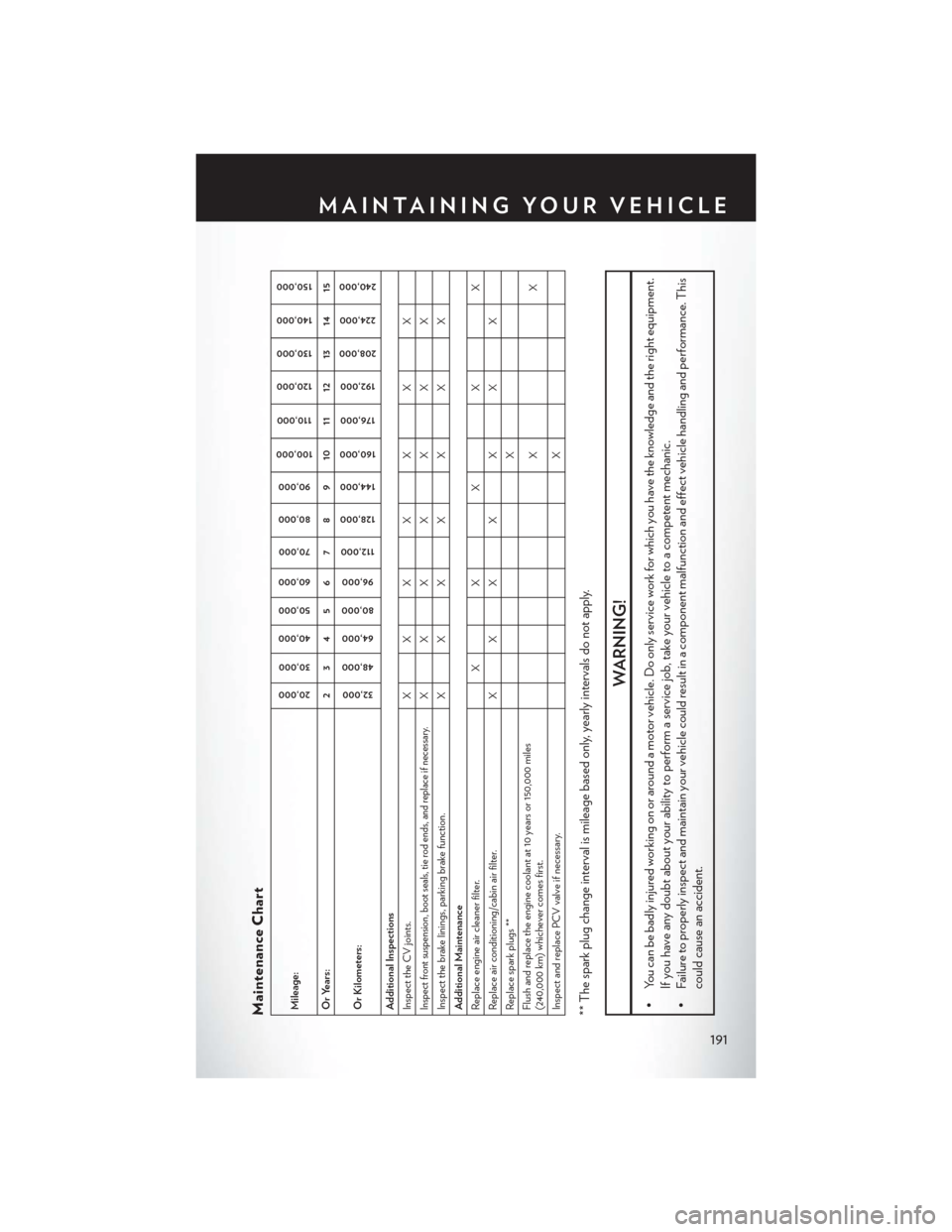
Maintenance ChartMileage:
20,00030,000
40,000 50,000
60,000
70,000
80,000 90,000
100,000
110,000
120,000 130,000
140,000 150,000
Or Years: 2 3 4 5 6 7 8 9 10 11 12 13 14 15
Or Kilometers:
32,000
48,000
64,000
80,000
96,000
112,000
128,000
144,000
160,000
176,000
192,000
208,000
224,000
240,000
Additional Inspections
Inspect the CV joints. X X X X X X XInspect front suspension, boot seals, tie rod ends, and replace if necessary.
XXX X X X X
Inspect the brake linings, parking brake function. X X X X X X X
Additional Maintenance
Replace engine air cleaner filter. X X X X X
Replace air conditioning/cabin air filter. X X X X X X X
Replace spark plugs ** X
Flush and replace the engine coolant at 10 years or 150,000 miles
(240,000 km) whichever comes first. XX
Inspect and replace PCV valve if necessary. X
** The spark plug change interval is mileage based only, yearly intervals do not apply.
WARNING!
• You can be badly injured working on or around a motor vehicle. Do only service work for which you have the knowledge and the right equipment.
If you have any doubt about your ability to perform a service job, take your vehicle to a competent mechanic.
• Failure to properly inspect and maintain your vehicle could result in a component malfunction and effect vehicle handling and performance. This
could cause an accident.
MAINTAINING YOUR VEHICLE
191
Page 194 of 220

MAINTENANCE RECORD
Odometer Date Signature, AuthorizedService Center
20,000 Miles
(32,000 km) or
2 Years
30,000 Miles
(48,000 km) or
3 Years
40,000 Miles
(64,000 km) or
4 Years
50,000 Miles
(80,000 km) or
5 Years
60,000 Miles
(96,000 km) or
6 Years
70,000 Miles
(112,000 km) or
7 Years
80,000 Miles
(128,000 km) or
8 Years
Odometer Date Signature, Authorized Service Center
90,000 Miles
(144,000 km) or
9 Years
100,000 Miles
(160,000 km) or
10 Years
110,000 Miles
(176,000 km) or
11 Years
120,000 Miles
(192,000 km) or
12 Years
130,000 Miles
(208,000 km) or
13 Years
140,000 Miles
(224,000 km) or
14 Years
150,000 Miles
(240,000 km) or
15 Years
MAINTAINING YOUR VEHICLE
192
Page 195 of 220

FUSES
Power Distribution Center (Fuses)
The Power Distribution Center is located in the engine compartment near the battery. This
center contains cartridge fuses, mini-fuses and relays. A label that identifies each component is
printed on the inside of the cover.
Cavity Blade FuseCartridge FuseDescription
F06 – –Not Used
F07 – –Not Used
F08 25 Amp Clear –Engine Control Module
(ECM) / Fuel Inj.
F09 – –Not Used
F10 20 Amp Yellow –Power Transfer Unit
(PTU) – If Equipped
F11 – –Not Used
F12 20 Amp Yellow –Brake Vacuum Pump – If
Equipped
F13 10 Amp Red –Engine Control Module
(ECM) / VSM (Stop/Start Only)
F14 10 Amp Red –Drivetrain Control Module
(DTCM) / Power TransferUnit (PTU) – If Equipped / RDM / Brake System
Module (BSM) / Brake Pedal S.
F15 – –Not Used
F16 20 Amp Yellow –Powertrain / Ignition Coil
F17 – –Not Used
F18 – –Not Used
F19 –40 Amp Green Starter Solenoid
F20 10 Amp Red –A/C Compressor Clutch
F21 – –Not Used
F22 5 Amp Tan –Radiator Fan Enable
F23 70 Amp Tan –Body Controller Module
(BCM) – Feed 2
F23 50 Amp Red –Voltage Stability Module
(VSM) #2 – If Equipped With Stop/Start Engine Option
F24 – –Not Used
F25B 20 Amp Yellow –Front Washer Pump – If
Equipped with Stop/Start Option
MAINTAINING YOUR VEHICLE
193
Page 196 of 220
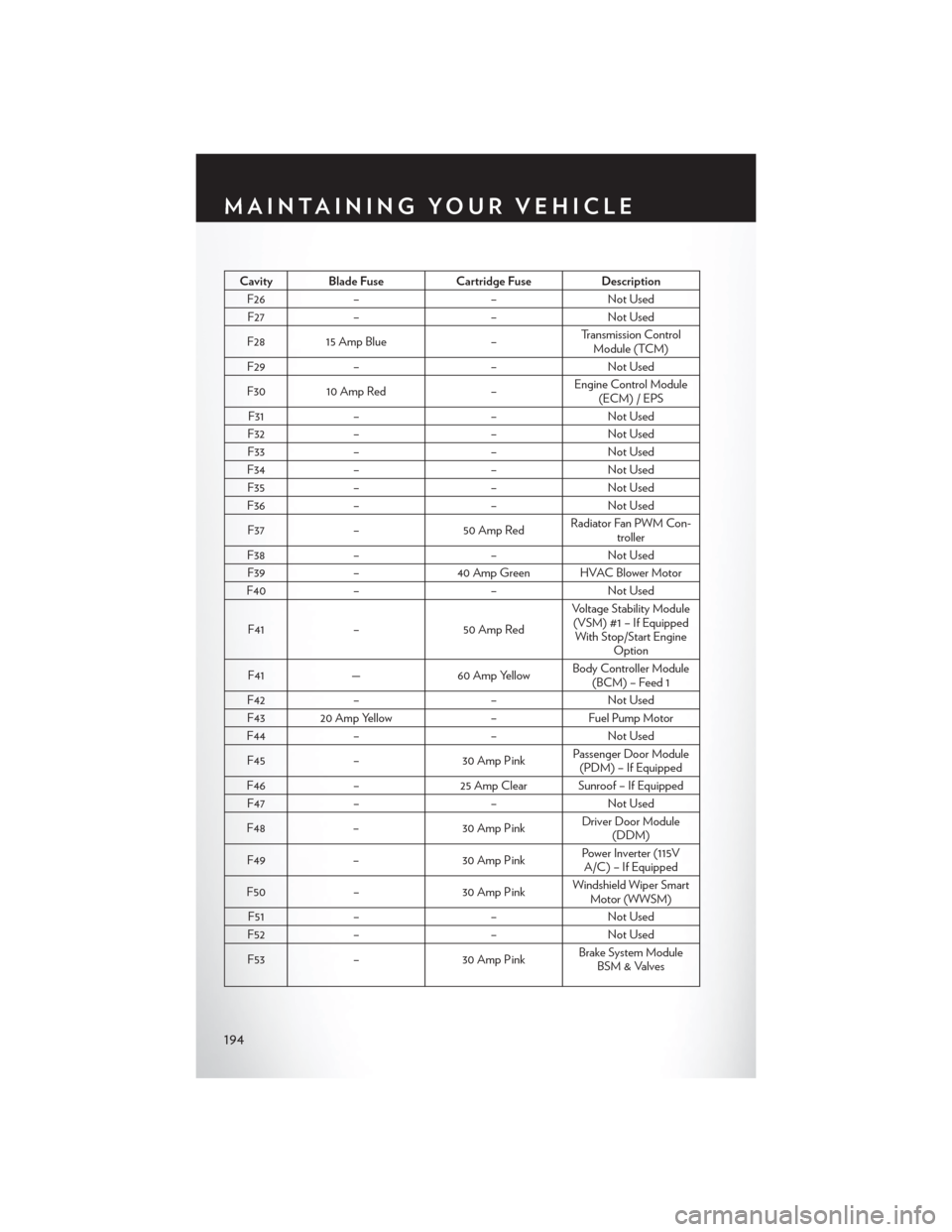
Cavity Blade FuseCartridge FuseDescription
F26 – –Not Used
F27 – –Not Used
F28 15 Amp Blue –Transmission Control
Module (TCM)
F29 – –Not Used
F30 10 Amp Red –Engine Control Module
(ECM) / EPS
F31 – –Not Used
F32 – –Not Used
F33 – –Not Used
F34 – –Not Used
F35 – –Not Used
F36 – –Not Used
F37 – 50 Amp RedRadiator Fan PWM Con-
troller
F38 – –Not Used
F39 –40 Amp Green HVAC Blower Motor
F40 – –Not Used
F41 – 50 Amp RedVoltage Stability Module
(VSM) #1 – If Equipped With Stop/Start Engine Option
F41 — 60 Amp Yellow Body Controller Module
(BCM) – Feed 1
F42 – –Not Used
F43 20 Amp Yellow –Fuel Pump Motor
F44 – –Not Used
F45 – 30 Amp Pink Passenger Door Module
(PDM) – If Equipped
F46 – 25 Amp Clear Sunroof – If Equipped
F47 – –Not Used
F48 – 30 Amp Pink Driver Door Module
(DDM)
F49 – 30 Amp Pink Power Inverter (115V
A/C) – If Equipped
F50 – 30 Amp Pink Windshield Wiper Smart
Motor (WWSM)
F51 – –Not Used
F52 – –Not Used
F53 – 30 Amp Pink Brake System Module
BSM & Valves
MAINTAINING YOUR VEHICLE
194
Page 197 of 220
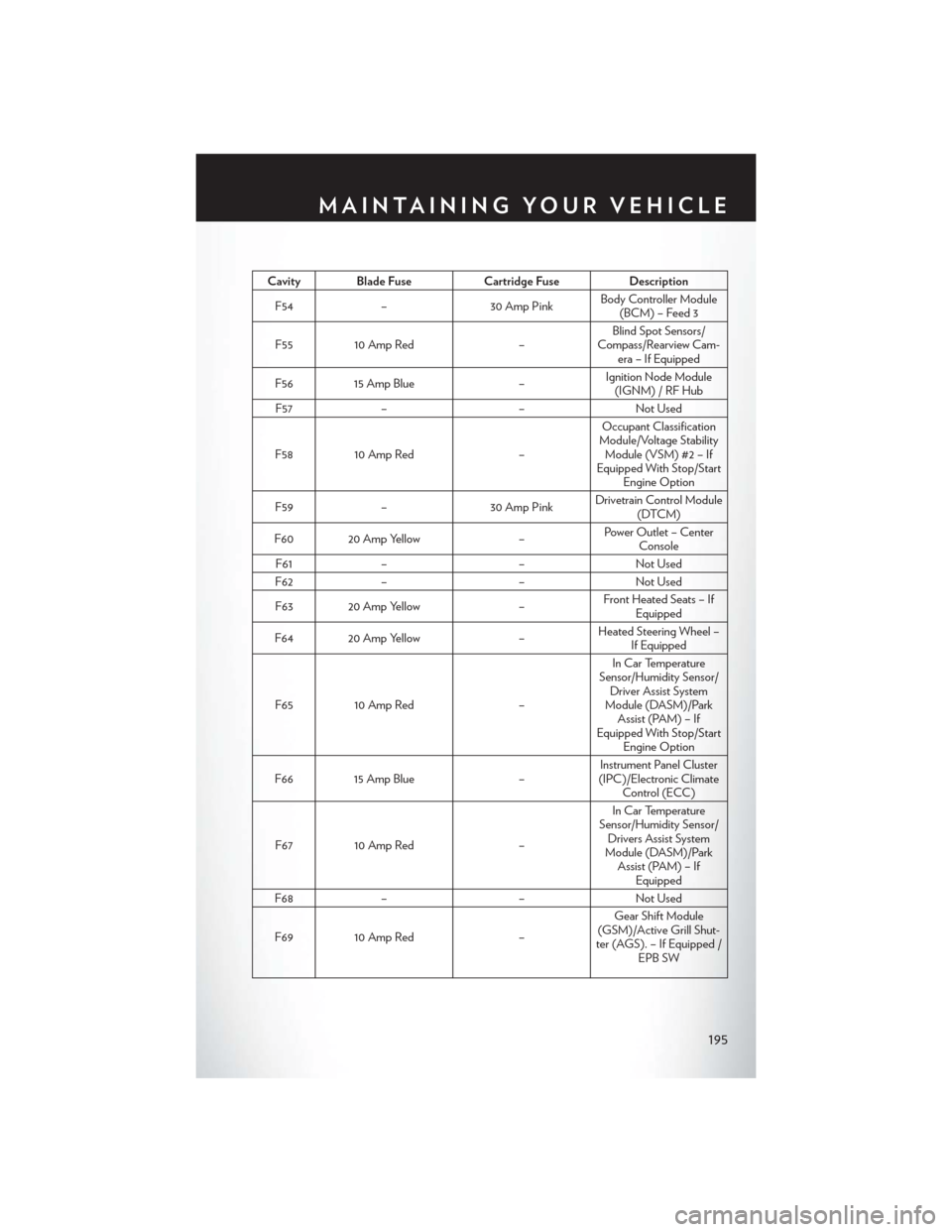
Cavity Blade FuseCartridge FuseDescription
F54 – 30 Amp Pink Body Controller Module
(BCM) – Feed 3
F55 10 Amp Red –Blind Spot Sensors/
Compass/Rearview Cam- era – If Equipped
F56 15 Amp Blue –Ignition Node Module
(IGNM) / RF Hub
F57 – –Not Used
F58 10 Amp Red –Occupant Classification
Module/Voltage Stability Module (VSM) #2 – If
Equipped With Stop/Start Engine Option
F59 – 30 Amp PinkDrivetrain Control Module
(DTCM)
F60 20 Amp Yellow –Power Outlet – Center
Console
F61 – –Not Used
F62 – –Not Used
F63 20 Amp Yellow –Front Heated Seats – If
Equipped
F64 20 Amp Yellow –Heated Steering Wheel –
If Equipped
F65 10 Amp Red –In Car Temperature
Sensor/Humidity Sensor/ Driver Assist System
Module (DASM)/Park Assist (PAM) – If
Equipped With Stop/Start Engine Option
F66 15 Amp Blue –Instrument Panel Cluster
(IPC)/Electronic Climate Control (ECC )
F67 10 Amp Red –In Car Temperature
Sensor/Humidity Sensor/ Drivers Assist System
Module (DASM)/Park Assist (PAM) – If Equipped
F68 – –Not Used
F69 10 Amp Red –Gear Shift Module
(GSM)/Active Grill Shut-
ter (AGS). – If Equipped / EPB SW
MAINTAINING YOUR VEHICLE
195
Page 198 of 220
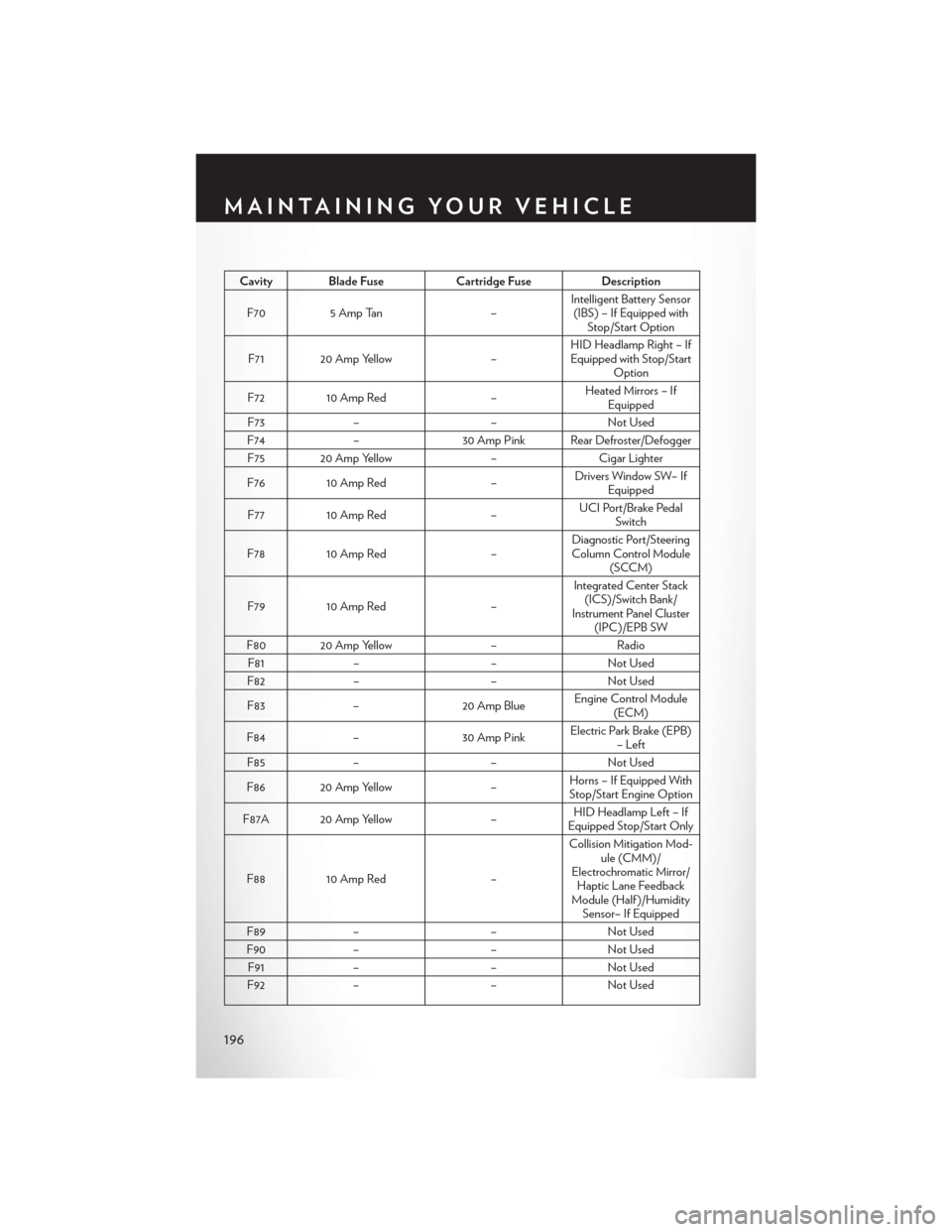
Cavity Blade FuseCartridge FuseDescription
F70 5 Amp Tan –Intelligent Battery Sensor
(IBS) – If Equipped with Stop/Start Option
F71 20 Amp Yellow –HID Headlamp Right – If
Equipped with Stop/Start Option
F72 10 Amp Red –Heated Mirrors – If
Equipped
F73 – –Not Used
F74 – 30 Amp Pink Rear Defroster/Defogger
F75 20 Amp Yellow –Cigar Lighter
F76 10 Amp Red –Drivers Window SW– If
Equipped
F77 10 Amp Red –UCI Port/Brake Pedal
Switch
F78 10 Amp Red –Diagnostic Port/Steering
Column Control Module (SCCM)
F79 10 Amp Red –Integrated Center Stack
(ICS)/Switch Bank/
Instrument Panel Cluster (IPC)/EPB SW
F80 20 Amp Yellow –Radio
F81 – –Not Used
F82 – –Not Used
F83 – 20 Amp Blue Engine Control Module
(ECM)
F84 – 30 Amp PinkElectric Park Brake (EPB)
– Left
F85 – –Not Used
F86 20 Amp Yellow –Horns – If Equipped With
Stop/Start Engine Option
F87A 20 Amp Yellow –HID Headlamp Left – If
Equipped Stop/Start Only
F88 10 Amp Red –Collision Mitigation Mod-
ule (CMM)/
Electrochromatic Mirror/ Haptic Lane Feedback
Module (Half )/Humidity Sensor– If Equipped
F89 – –Not Used
F90 – –Not Used
F91 – –Not Used
F92 – –Not Used
MAINTAINING YOUR VEHICLE
196
Page 199 of 220

Cavity Blade FuseCartridge FuseDescription
F93 –40 Amp Green Brake System Module
(BSM) – Pump Motor – If Equipped
F94 – 30 Amp PinkElectric Park Brake (EPB)
– Right
F95 10 Amp Red –Electrochromatic Mirror/
Rain/Pass. Window SW/ Power Outlet Console Illumination/Sensor/
Sunroof – If Equipped
F96 10 Amp Red –Occupant Restraint Con-
troller (ORC) (Airbag)
F97 10 Amp Red –Occupant Restraint Con-
troller (ORC) (Airbag)
F98 25 Amp Clear –Audio Amplifier – If
Equipped
F99 – –Not Used
F100 – –Not Used
Interior Fuses
The interior fuse panel is located in the passenger compartment on the left side dash panel under
the instrument panel.
CavityBlade Fuse Description
F13 15 Amp Blue Low Beam Left
F32 10 Amp Red Interior Lighting
F36 10 Amp Red Intrusion Module / Siren
F37 7.5 Amp Brown Aux. Switch Bank Module (ASBM)
F38 20 Amp Yellow All Doors Lock/Unlock
F43 20 Amp Yellow Washer Pump Front
F48 20 Amp Yellow Horns
F49 7.5 Amp Brown Lumbar Support
F51 10 Amp Red Driver Window Switch / Power Mirrors – If
Equipped
F53 7.5 Amp Brown UCI Port (USB & AUX)
F89 5 Amp Tan Trunk Lamp
F91 5 Amp Tan Fog Lamp Front Left
F92 5 Amp Tan Fog Lamp Front Right
F93 10 Amp Red Low Beam Right
MAINTAINING YOUR VEHICLE
197
Page 200 of 220
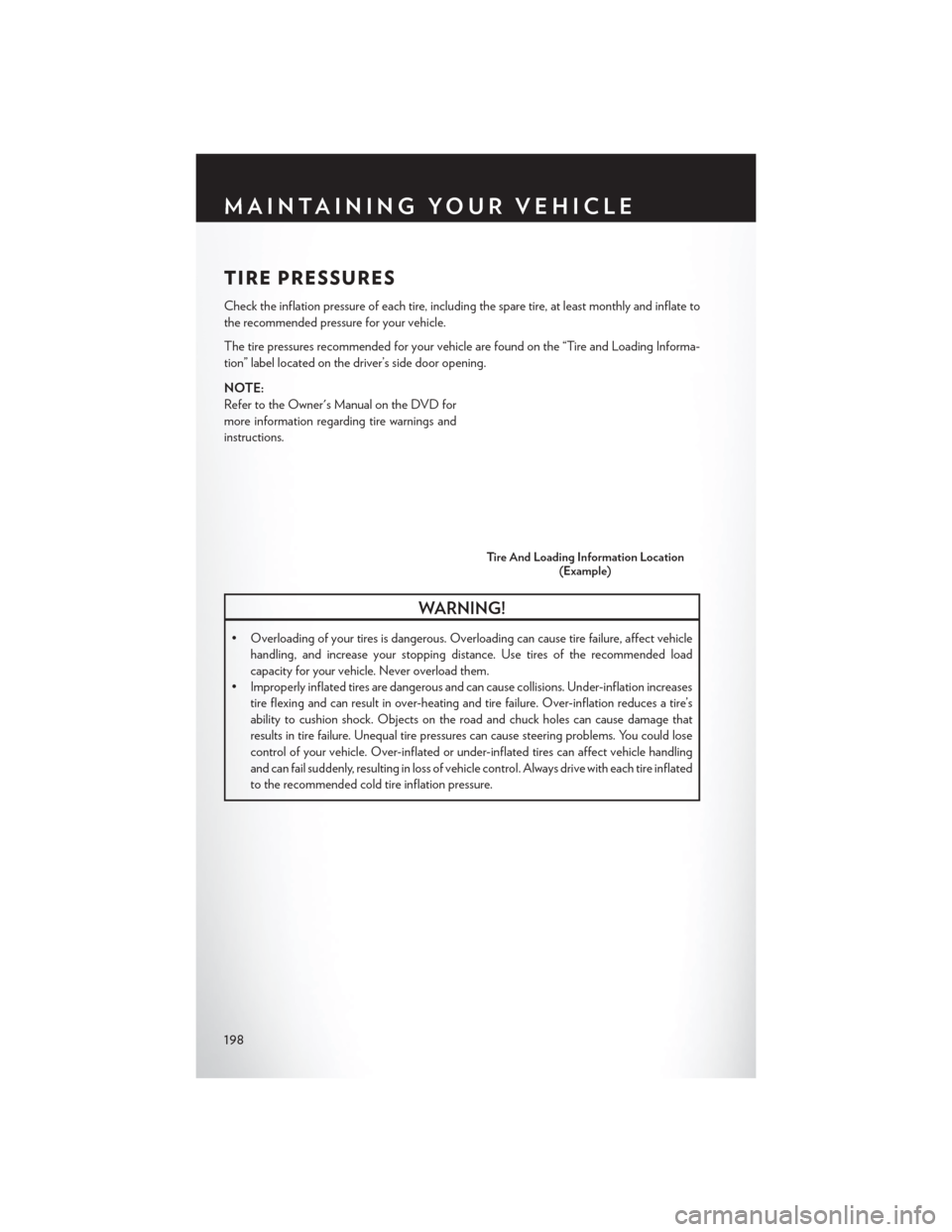
TIRE PRESSURES
Check the inflation pressure of each tire, including the spare tire, at least monthly and inflate to
the recommended pressure for your vehicle.
The tire pressures recommended for your vehicle are found on the “Tire and Loading Informa-
tion” label located on the driver’s side door opening.
NOTE:
Refer to the Owner's Manual on the DVD for
more information regarding tire warnings and
instructions.
WARNING!
• Overloading of your tires is dangerous. Overloading can cause tire failure, affect vehiclehandling, and increase your stopping distance. Use tires of the recommended load
capacity for your vehicle . Never overload them.
• Improperly inflated tires are dangerous and can cause collisions. Under-inflation increases
tire flexing and can result in over-heating and tire failure. Over-inflation reduces a tire’s
ability to cushion shock. Objects on the road and chuck holes can cause damage that
results in tire failure. Unequal tire pressures can cause steering problems. You could lose
control of your vehicle. Over-inflated or under-inflated tires can affect vehicle handling
and can fail suddenly, resulting in loss of vehicle control. Always drive with each tire inflated
to the recommended cold tire inflation pressure.
Tire And Loading Information Location (Example)
MAINTAINING YOUR VEHICLE
198